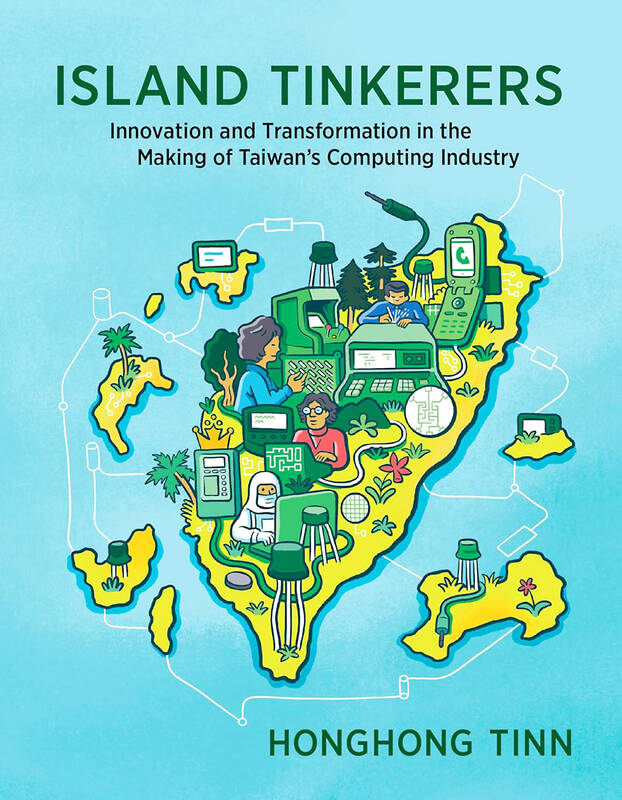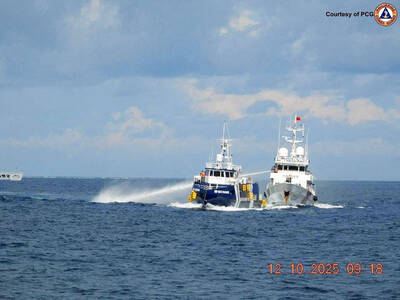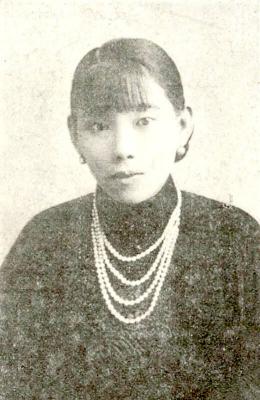It was only a matter of time before US President Donald Trump set his sights on Taiwan. Based on his congratulatory phone call to former president Tsai Ing-wen (蔡英文) after her return to power in 2020, the more optimistic among us might have hope for continued support.
Alas, Trump 2.0 is a proposition that has taken even the most canny and cynical of observers by surprise with the aggression he and his administration have shown toward traditional allies. Following threatened tariffs against Canada and Mexico and hints of the same against Europe, Trump raised the prospect of trade sanctions against Taiwan, which he accused of stealing US microprocessor know-how.
“Taiwan took our chip business away,” Trump told a press conference on Feb. 13. He followed this up with a threat of 100 percent duties on chips from Taiwan “if they don’t bring it back.”

To anyone who had been listening to his campaign pledges, it shouldn’t have been a bombshell. In July last year, Trump had told Bloomberg that Taiwan stole the US’ chip manufacturing industry, that Taipei gave America nothing and that, as such, it should pay Washington for defense just like “an insurance policy.”
Economists and industry experts quickly pointed to the impracticalities of Trump’s strategy, arguing that hitting Taiwan with exorbitant tariffs would simply drive high-end chip prices up, with US consumers footing the bill. The idea that this was would suddenly drive reshoring was also dismissed, with the five-year lead time on Taiwan Semiconductor Manufacturing Co’s (TSMC) first Arizona fab, set to open this year, offered as an example of how long these things take, and the obvious issues of labor costs highlighted.
Elsewhere, Trump’s critics charged that the president betrayed a fundamental misunderstanding of how the semiconductor industry works: The US, they explained, was largely responsible for chip design, while Taiwan focused on manufacturing. President William Lai (賴清德) echoed these remarks, calling the industry an “ecosystem” which relied on a division of labor.
In response, Trump might argue that this was not always so. As Honghong Tinn (鄭芳芳) writes in this engrossing and meticulously researched new book, it wasn’t until 1987, when Morris Chang (張忠謀) founded TSMC as the world’s first dedicated or pure-play foundry, that these distinct roles emerged. Prior to that, leading US technology companies, such as Intel, IBM and Texas Instruments and Asian giants such as Samsung and Toshiba had been integrated device manufacturers, handling all aspects of chip design and fabrication.
REPLICATING SUCCESS
The dedicated foundry model, which Tinn notes may have been pilfered from then-UMC chairman Robert Tsao (曹興誠), who had previously consulted Chang about the feasibility of such an undertaking, was established after Taiwan’s “godfather of technology” minister without portfolio Li Kwo-ting (李國鼎) persuaded Chang to relocate to Taiwan to head the Industrial Technology Research Institute (ITRI).
Unlike most of the technologists featured in this book, Chang had never previously lived in Taiwan but “had shaped Taiwan’s electronics industry in a substantive manner” as an informal advisor to the government on technology transfer projects, establishment of manufacturing facilities, and subcontracting work for Texas Instruments and, later, General Instrument.
Chang and Tsao’s hunch that dedicated foundries were the way forward for Taiwan was based on several considerations, including the belief that the tinkering-based know-how that had brought Taiwan’s researchers, engineers and technicians success in computer manufacturing could be replicated in the production of integrated circuits (ICs). Another prediction was that IC demand would soon explode, leading electronics companies that lacked the requisite expertise to outsource production.
In such an environment, large-scale manufacturers would thrive, Chang believed. He was also inspired by Introduction to VLSI System, a legendary textbook by a pair of American computer scientists that is credited with spawning the IC design industry and the division with manufacturing.
MISSING THE BOAT
More evidence that all of this started before America needed making great again, the Magadonians will insist. Perhaps. But, leaving aside the issues of legitimate technology transfer through official cooperation, the emergence of transnational supply chains, and the legions of US-educated Taiwanese- and Chinese-Americans who moved seamlessly between countries and institutions, a key point missed by those who cry theft is that the US big guns were invited in from the get-go, but declined.
In fact, on trips to the US to raise seed money, Chang failed to get a hearing with most companies who considered his proposal “unfeasible.” The two that did receive his pitch — Intel and Texas Instruments — politely declined. In the end, Dutch multinational Philips was the sole foreign investor with 27.5 percent of the startup capital.
True, Intel did soon send personnel to Taiwan to finesse TSMC’s processes with a view to eventually having them subcontract. This began with “leftover” contracts but, with Intel soon unable to fulfil orders, quickly became an official “qualified” independent contractor arrangement. By the mid-1990s, most of TSMC’s sales were to fabless design firms.
But all of this misses the point: Trump’s playbook on how to lose friends and alienate people tramples all over a relationship that was and continues to be founded on mutual benefit.
‘ASPIRATIONAL TINKERERS’
Tracing the history of Taiwanese tinkering to National Chiao Tung University (NCTU) alumni who pushed for the re-establishment of the institution in Taiwan, Tinn not only contradicts received wisdom about top-down processes, but she also shows how this was a transnational process from the start.
To be sure, officials played a role, with vice minister of communications Chien Chi-chen (錢其琛) pushing the bid for technical assistance under a United Nations Special Program — the kind of fruitful cooperation that Trump and his enforcer Elon Musk are currently attempting to end.
In her conclusion, Tinn uses the example of a US high school team comprising undocumented immigrants which bested a group of MIT grads in a robot design competition to highlight what “aspirational tinkerers” can achieve.
Chien and other early technologists cunningly secured government approval by tying the field of electrical engineering to atomic energy — an obsession of Chiang Kai-shek (蔣中正) and his Chinese Nationalist Party government.
There are, Tinn notes in her conclusion, clear parallels with the way Taiwan’s contemporary technologists have made their products indispensable — not only to their own national defense but to that of the US and, indeed, the world. Trump would do well to remember where some of the specialized chips used in American fighter jets are sourced.
Aside from pragmatic concerns, something more affecting, more essential permeates the pages of this remarkable story: the close personal bonds that were formed between generations of innovators that form the book’s dramatic personae.
Recalling fondly his time as training at an electronics factory in Watseka, Illinois, in the 1960s, Bruce C.H. Cheng (鄭崇華) — who would later found Delta Electronics — was struck by the camaraderie he was shown.
His American coworkers were aware that their company was poised to establish a Taiwan facility, jeopardizing their own livelihoods. Joking that they would be hastening their redundancy if Cheng learned too fast, they nevertheless took him under their wing.
“[They] remained enthusiastic about teaching Cheng and his fellow Taiwanese colleagues every part of the production,” writes Tinn, “and they generously took turns inviting Cheng and others to each of their homes.”

Many people noticed the flood of pro-China propaganda across a number of venues in recent weeks that looks like a coordinated assault on US Taiwan policy. It does look like an effort intended to influence the US before the meeting between US President Donald Trump and Chinese dictator Xi Jinping (習近平) over the weekend. Jennifer Kavanagh’s piece in the New York Times in September appears to be the opening strike of the current campaign. She followed up last week in the Lowy Interpreter, blaming the US for causing the PRC to escalate in the Philippines and Taiwan, saying that as

This year’s Miss Universe in Thailand has been marred by ugly drama, with allegations of an insult to a beauty queen’s intellect, a walkout by pageant contestants and a tearful tantrum by the host. More than 120 women from across the world have gathered in Thailand, vying to be crowned Miss Universe in a contest considered one of the “big four” of global beauty pageants. But the runup has been dominated by the off-stage antics of the coiffed contestants and their Thai hosts, escalating into a feminist firestorm drawing the attention of Mexico’s president. On Tuesday, Mexican delegate Fatima Bosch staged a

Nov. 3 to Nov. 9 In 1925, 18-year-old Huang Chin-chuan (黃金川) penned the following words: “When will the day of women’s equal rights arrive, so that my talents won’t drift away in the eastern stream?” These were the closing lines to her poem “Female Student” (女學生), which expressed her unwillingness to be confined to traditional female roles and her desire to study and explore the world. Born to a wealthy family on Nov. 5, 1907, Huang was able to study in Japan — a rare privilege for women in her time — and even made a name for herself in the

Taiwan can often feel woefully behind on global trends, from fashion to food, and influences can sometimes feel like the last on the metaphorical bandwagon. In the West, suddenly every burger is being smashed and honey has become “hot” and we’re all drinking orange wine. But it took a good while for a smash burger in Taipei to come across my radar. For the uninitiated, a smash burger is, well, a normal burger patty but smashed flat. Originally, I didn’t understand. Surely the best part of a burger is the thick patty with all the juiciness of the beef, the